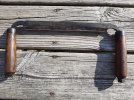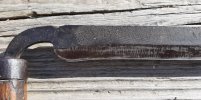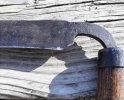- Joined
- Jul 3, 2019
- Messages
- 14,659
I have a lot of experience whittling walking sticks with a pocket knife or cutting off the corners of larger turning projects with a saw. I’ve been interested in a draw knife for a while, which I imagine works similar to a spokeshave with more “hogging” ability.
I’ve looked at all kinds on the current market and I’ve been a little disappointed in what I see.
I’m familiar with Narex steel, and it’s decent but requires sharpening more often than some. With the blade of 5/8 width it doesn’t seem like there’s much longevity in that blade.
Ramelson didn’t get great reviews and Veritas is super expensive- not to mention I don’t feel like there’s much room for blade shrinkage over the sharpening life of the tool.
timber tuff is only heat treated to 30 HRC?? (For maximum edge retention, the site says lol)
Crown is a little expensive and the reviews seem to indicate it’s not what it should be for the money.
I think I’d prefer handles roughly in the same plane as the blade, though I don’t care if they are 45*, 90* or parallel to the blade. Id like a straight blade and decent steel. I’d also like to not have to do a lot of bevel treatment- grinding, honing or otherwise, though I always expect to put an edge on it.
so far, ox-head seems my best bet, but even those reviews aren’t amazing.
looking for some pro tips here! Thank you in advance.
I’ve looked at all kinds on the current market and I’ve been a little disappointed in what I see.
I’m familiar with Narex steel, and it’s decent but requires sharpening more often than some. With the blade of 5/8 width it doesn’t seem like there’s much longevity in that blade.
Ramelson didn’t get great reviews and Veritas is super expensive- not to mention I don’t feel like there’s much room for blade shrinkage over the sharpening life of the tool.
timber tuff is only heat treated to 30 HRC?? (For maximum edge retention, the site says lol)
Crown is a little expensive and the reviews seem to indicate it’s not what it should be for the money.
I think I’d prefer handles roughly in the same plane as the blade, though I don’t care if they are 45*, 90* or parallel to the blade. Id like a straight blade and decent steel. I’d also like to not have to do a lot of bevel treatment- grinding, honing or otherwise, though I always expect to put an edge on it.
so far, ox-head seems my best bet, but even those reviews aren’t amazing.
looking for some pro tips here! Thank you in advance.
Last edited:




